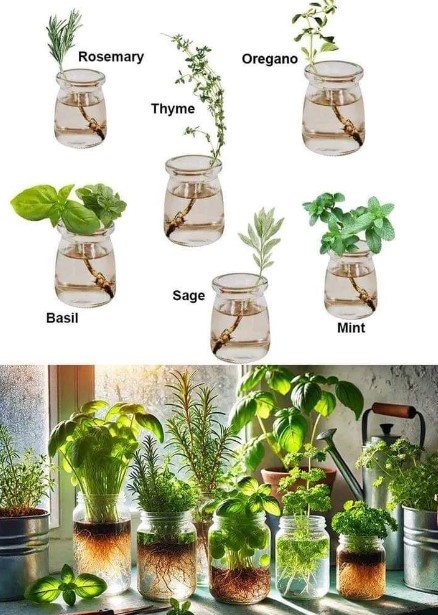
Table of Contents
Growing herbs in water is an easy, space-saving solution for indoor gardeners or those with limited outdoor space. Not only does this method keep your kitchen filled with fresh herbs year-round, but it also minimizes the need for soil and frequent watering. Here are seven herbs that thrive in water and how you can grow them at home.
1. Basi
Basil is one of the most popular herbs for water propagation. It’s a favorite in the kitchen for its aromatic leaves, perfect for sauces, salads, and garnishes.
- How to grow: Start by taking a cutting of basil (about 4-6 inches long) from a healthy plant, ensuring it has at least two pairs of leaves. Place the stem in a glass of water, making sure no leaves are submerged to prevent rot. Change the water every few days, and within 2-3 weeks, roots should start to form. Once the roots are about 2 inches long, you can either transfer the plant to soil or continue growing it in water.
2. Mint
Mint is incredibly easy to grow in water and can quickly spread if planted in soil, making it an ideal candidate for contained water growth. It’s perfect for teas, desserts, and refreshing drinks like mojitos.
- How to grow: Take a mint cutting from a healthy plant and strip the leaves off the lower half of the stem. Place the stem in a glass jar or bottle filled with water, and change the water every 3-4 days. Within 1-2 weeks, roots will begin to form. Mint does well in indirect sunlight, making it great for indoor growing.
3. Oregano

Oregano is a hardy herb that flourishes in water. This Mediterranean staple is great for seasoning pizzas, soups, and pasta dishes.
- How to grow: Cut a sprig of oregano about 5-6 inches long from an existing plant. Place the cutting in a glass of water on a sunny windowsill. Keep the water fresh by changing it every few days. Once roots form (usually in 2-3 weeks), you can either pot the plant or leave it in water for continuous growth.
4. Thyme

Thyme is a resilient herb that adapts well to water-based growing. It’s commonly used in seasoning meats, soups, and stews, and its medicinal properties are also highly valued.
- How to grow: Snip off a fresh thyme cutting about 3-4 inches long. Place the stem in a container of water and change the water every 2-3 days to keep it fresh. Thyme will start growing roots in about 2-4 weeks, after which it can be kept in water or transferred to a pot.
5. Rosemary

Although rosemary can take longer to root in water compared to other herbs, it’s worth the wait. This fragrant herb is great for roasting meats and vegetables and can even be used in homemade skincare.
- How to grow: Cut a 6-8 inch stem from a mature rosemary plant. Strip the lower leaves and place the stem in a glass of water. Keep the rosemary in a sunny spot and change the water every few days. Roots may take up to 6-8 weeks to appear, but once they do, rosemary can be grown in water indefinitely.
6. Sage

Sage has a robust flavor and is a key ingredient in many savory dishes, especially during the fall and winter months. It’s another herb that adapts well to growing in water.
- How to grow: Take a 4-5 inch cutting from a healthy sage plant and place it in a container of water. Sage prefers indirect sunlight, so it’s best placed in a well-lit area that doesn’t get direct sun exposure. Change the water regularly, and roots should begin to form in about 3 weeks.
7. Lemon Balm

Lemon balm is a lemon-scented herb from the mint family that is known for its calming properties. It can be used in teas, desserts, and as a garnish.
- How to grow: Take a 5-6 inch cutting from a lemon balm plant, strip off the lower leaves, and place it in a jar of water. Lemon balm does best in indirect sunlight and should have its water changed every few days. Roots will develop in about 2-3 weeks, after which you can continue growing it in water.
How to Care for Herbs Growing in Water
- Water Quality: Use filtered or rainwater to avoid chemicals that may be present in tap water.
- Change Water Regularly: To prevent algae growth and rotting, change the water every 3-4 days.
- Light: Most herbs need 4-6 hours of indirect sunlight daily. If your space lacks natural light, consider using a grow light.
- Pruning: Regularly trim the herbs to encourage healthy growth and prevent them from becoming leggy.
Conclusion
Growing herbs in water is an easy and eco-friendly way to have fresh herbs year-round, even in small spaces. These seven herbs not only grow well in water but are also incredibly versatile in the kitchen. Whether you’re looking to enhance your meals or add greenery to your indoor space, water-grown herbs are a perfect solution for any gardener